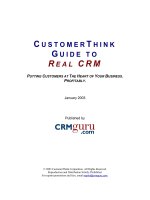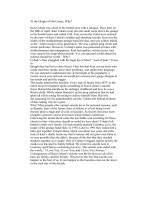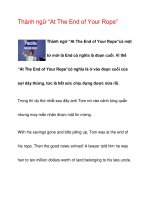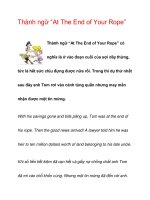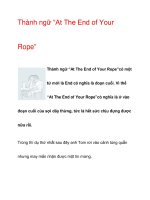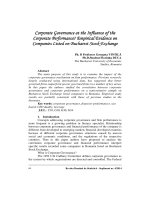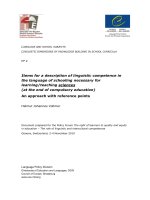Hebert_School-at-the-Heart-of-Integration_Sept2011
Bạn đang xem bản rút gọn của tài liệu. Xem và tải ngay bản đầy đủ của tài liệu tại đây (140.28 KB, 16 trang )
The School at the Heart of Integration:
Making Schools Just?
Yvonne Hébert
University of Calgary
Author Contact:
T: 403.220.7361
Presentation at the
Citizenship Knowledges and Education:
CGCER International Citizenship Conference 2011
October 7-8, Faculty of Education, University of Alberta, Edmonton
DRAFT PAPER – DO NOT QUOTE WITHOUT PERMISSION
Abstract: Set in the context of current debates focussing on diversity and youth rioting, part of
larger debates about the paradoxical representation and nature of youth, the role of the school is
considered in light of three approaches to social justice: distributive, retributive and recognitive,
and their implications for making schools just. The creation of school board policies, social
practices and the establishment of norms are reviewed and commented upon with respect to
forms of social justice needed for democratically just schooling.
Yvonne Hébert, School at the Heart of Integration: Making Schools Just,
Citizenship Knowledges and Education Conference, UA, Edmonton, 7-8 October 2011
Schooling Matters
The school stands at the very heart of the integrative process that is Canada. The school is a
micro-society in which can be found power relations, inequalities, injustices, and privileges.
Social stratification is also observable in the school, according to class, the rich and the poor, the
brilliant and the less gifted. Some students are ranked as successes and others as failures. The
school is the only public institution where attendance is made obligatory by law. Given its broad
mandate to ‘educate’ in modern democratic societies, it is much more than a simple purveyor of
educational services. Rather the school intervenes in the socialisation of young people as well as
in their construction of identifications, attitudes and values.
Current public debates about supporting diversity and multiculturalism while promoting
cohesion live on1. Yet the dark side of pluralism provides stark evidence of deep-seated tensions
in several countries, including Canada. This is evident in several examples over time, all
involving youth. Breaking out on the weekend of August 8 th, 2011, the London riots have been
attributed to racial tensions, high youth unemployment rates, austerity cuts on the part of
government, a desire to loot and profit in the midst of chaos, poverty, socio-economic exclusion,
the closure of youth clubs, and policing policy. Given these highly plausible factors, the riots
were imminently predictable2. By comparison, the youth riots in Vancouver over the Canucks’
loss in the Stanley Cup finals in August 2011 were attributed to opportunity, alcohol and
anonymity3, an attribution which does not, however, address underlying educational, societal,
and individual responsibilities or possible causes.
The fear of youth violence showed up much earlier, in Toronto, with the periodic fear of
youth violence, for example, with the July shooting of Ephraim Brown, 11 years, in the midst of
1
Bloemraad, I., The Debate Over Multiculturalism: Philosophy, Politics, and Policy, Migration Information Source,
7 pp., downloaded on October 6, 2011;
2
Predictions of youth riots after the closure of youth clubs, reported in the July 31st issue of the Guardian, six days
before they actually occurred: ;Reports of 08 August 2011 in the Atlantic emphasized the criminality of rioting youth, illustrated by 41
photos, following upon the killing of a 29 year old man, father of four children, by armed police, on August 4 th:
David Hill post:
Levintova,
Hannah & Samantha Oltman, ;all
downloaded on October 6, 2011.
3
A riot in Vancouver over the Canucks' loss in the Stanley Cup final resulted in similar devastation to the London
riots, ( but Catherine Corrigall-Brown, a psychologist,
said alcohol and anonymity caused young Canadians hockey fans to let loose and forget about the consequences
(Global Network, August 09, 2011). Global News | Canadian youth unlikely to riot under social pressure:
psychologists Young Canadians did take to the streets in Vancouver in June after the city's Canucks lost in the
Stanley Cup playoffs, but the protest was one of opportunity than of political purpose.
2
Yvonne Hébert, School at the Heart of Integration: Making Schools Just,
Citizenship Knowledges and Education Conference, UA, Edmonton, 7-8 October 2011
gang warfare in a public housing project in 2007, with two men acquitted of the killing in
December 20104. In hindsight, the Québécois debate around some young boys wearing a Sikh
religious symbol, the kirpan, sealed and sewn under garments, seemed almost like collective
hysteria in 2006 through early 20075.
Theoretical Considerations
There are dramatic changes in social, economic and political culture which impinge upon young
people, so it becomes important to consider the interplay between youth’s agency and social
structure and how this influences portrayals of youth. Within global marketisation, youth are
both workers and consumers, spending their meager wages for leisure and fashion items. The
increasing loss of position of states lessens the power of citizens and its attractiveness for youth.
Welfare systems and states are limited in their capacity or will to care for citizens’ well-being.
Extreme individualization challenges the collective, not only youth’s sense of belonging but also
the state’s capacity to create an ‘imagined’ community 6. The polarization of citizens into
successful individuals and losers has become commonplace.
Two issues concerning the polarized portrayal of youth are germane to our discussion: (1)
the paradoxical representations of youth and (2) the debate on the nature of youth. According to
one view, youth are threats to the social order, being poor, unemployed, excluded, marginalized,
and even terrorists-in-training. From another view, youth are “agents of change, citizens and
leaders, participants and activists, nations’ most important assets, the best hope and promise we
have for our collective future development and prosperity” 7. Yet this paradox is resolved upon
consideration of the place youth occupy at the nexus of contemporary political and economic
development discourse.
The incorporation of youth in a global, neo-liberal economic system allows only for two
positions: as willing and enthusiastic insiders who are welcomed and celebrated, or as outsiders,
4
Powell, Betsy, Toronto Star, December 13, 2010, />5
Maryse Potvin, Geneviève Audet & Marie McAndrew, « Dérapages racistes. Analyse des réactions à l’égard du
jugement sur le port du kirpan à l’école dans la presse écrite québécoise en 2006 », Communication du 28 mars
2007; disponible sur le site WEB de la Chaire du Canada Éducation et rapports ethniques :
www.ceetum.umontreal.ca/pdf/Maryse%20Potvin-Jugement%20du%20Kirpan%20(4).pdf
6
Anderson, B. (1983), Imagined Communities: Reflections on the Origin and Spread of Nationalism.
London: Verso.
7
Sukarieh, M. and S. Tannock, (2008), In the best interests of youth or neoliberalism? The World Bank and the New
Global Youth Empowerment Project. Journal of Youth Studies, 11, 3: 302.
3
Yvonne Hébert, School at the Heart of Integration: Making Schools Just,
Citizenship Knowledges and Education Conference, UA, Edmonton, 7-8 October 2011
questioning or challenging its basic principles and promises, “framed as global society’s worst
nightmare”8. Thus, youth’s marginal social and economic conditions worldwide have become an
urgent concern and strategy of international organisations such as the World Bank (2005, 2006),
the United Nations, the International Labour Organisation, as well as international aid
organisations including the Canadian International Development Agency (CIDA), the Policy
Research Initiative (PRI), and the new Secretariat on Youth (Dept. of Canadian Heritage), tying
together rhetoric, funding, personnel and institutional linkages.
The nature of youth, as a free-choice agent or subject to structural pressures and change,
is critical to our discussion of youth in the context of schooling as socially just. Youth as a social
and chronological construct was created with the emergence of the industrial revolution 9 and its
concomitant changing requirements for labour, family structure and home life. Integral to the
core of capitalist development, youth were recruited as new labour to sites of production,
including the targeting of teenagers to work in the new fast-food and retail chain outlets that have
spread across North America since the 1950s. This development continues apace, to cite but one
example, where in Alberta in 2006, the then Klein government lowered the age of work to 12 in
the food and tourist industries, legislation that has yet to be reconsidered 10.
How then do schools persuade young children and adolescents that Canada is a safe
place? How do schools take up the work of integrating young people, of developing national
identities in a globalising world, of respecting diversity, of negotiating difference, of engaging in
democratic practices, and of developing rational individuals? Let us consider how schooling can
be socially just, how schools create norms and practices; and how schooling is part of the
cultural politics that characterise Canada.
How can schooling be socially just?
Social justice is basically the will to render to everyone their due. Notions of social justice
however vary according to whose desire is at stake, how it is to be achieved, who benefits –
individuals or groups, the powerful or the disadvantaged - and what it should deliver – public or
private social goods. Although one person’s use of a public good does not reduce its value to
8
Sukarieh & Tannock, (2008): 302.
Ariès, P., (1965), Centuries of Childhood. New York: Vintage; Gillis, J. (1974), Youth and History. New York:
Academic Press.
10
Shultz, L. and Taylor, A. (2006). Children at work in Alberta. Canadian Public Policy, 32(4): 431-442.
9
4
Yvonne Hébert, School at the Heart of Integration: Making Schools Just,
Citizenship Knowledges and Education Conference, UA, Edmonton, 7-8 October 2011
someone else, education does use up public assets and may be costly, especially at the postsecondary level where it is increasingly thought of an individual benefit rather than a common
good. These considerations influence different perspectives on social justice in education. Let us
briefly look at three accounts of social justice and then link these to the mission of the school as
well as the establishment and interpretation of school board policies regarding multiculturalism
and anti-racism.
Notions of Social Justice
Three explanations of social justice take up a diversity of meanings and offer plausible and
useful accounts for considerations of schooling in contemporary contexts. 11 What is fair, right
and good? How is that determined?
Distributive conceptions of social justice assume that individuals have intrinsic value and
worth, which becomes the primary rationale for the distribution of goods and resources. An
example of this conception, Rawls’ model12 involves two main principles: individual freedom
and the equal distribution of material and social goods, unless an unequal distribution would
benefit those who have unfavourable starting positions. This has been understood in two
versions. A deficit model of social justice, premised on ‘simple equality’, 13 argues that all
individuals have the same basic needs. In schools, this liberal-democratic approach to
distributive social justice is a compensatory model, in which disadvantaged individuals are
considered to be deficient, as determined by the dominant group, leading to the provision of
remedial classes. A social-democratic notion of distributive social justice, premised on ‘complex
equality’,14 argues for the distribution of different social goods to different people. Equality of
opportunity takes into account student backgrounds and extends access to previously
unattainable material goods while maintaining the fiction that all have the same basic needs and
can abide by a consistent set of rules for everyone.
A retributive conception of social justice emphasises the processes of production of
goods. As in market logic, individuals are deemed to be entitled to differential rewards according
to their different contributions to productive and competitive processes. Merit systems exemplify
11
Trevor Gale & Kathleen Densmore, Just Schooling: Explorations in the cultural politics of teaching, Open
University Press, Buckingham, 2000.
12
John Rawls, A Theory of Justice, Oxford University Press, Oxford, 1971,
13
Michael Walzer, Spheres of Justice, Blackwell, Oxford, 1983.
14
Ibid, Walzer, 1983.
5
Yvonne Hébert, School at the Heart of Integration: Making Schools Just,
Citizenship Knowledges and Education Conference, UA, Edmonton, 7-8 October 2011
this notion of social justice whereby students are ranked according to their individual academic
performances and rewarded differentially.15 Identifying talent is problematic as schools tend to
reward those who conform to the language, culture and values of the educational establishment.
Candidates selected for leadership training, for example, tend to resemble the teachers-in-charge
of the programme. When faced with the acute need to provide extra time to a few students to
accommodate different learning styles, teachers may also live in tension with a distributive belief
that insists on equal service to all.
A recognitive conception of social justice reads both differences and commonalities
among cultural groups and acknowledges the place of social groups. 16 This approach provides
means for all people to exercise their capabilities and to determine their actions so that social
justice is achieved through democratic processes that generalise the interests of the least
advantaged. Benefiting all social groups, it favours positive self-identity, self-development and
self-determination. Recognitive justice requires the representation of the interests of groups and
their serious engagement within collective decision-making processes. In schools, the
development of educational services for ESL students, for example, would require parental
knowledge and community input on what would be appropriate educational programs, their
operation and anticipated outcomes. Hence, recognitive justice involves three necessary
conditions:17 (1) the fostering of respect for different social groups through their selfidentification; (2) opportunities for self-development and self-expression; and (3) the
participation of groups in decision making in matters of direct concern through representation on
determining bodies.
Thus, the three conceptions differ in their characteristics. 18 The distributive and
retributive approaches to social justice focus on assets such as material and economic goods,
only minimally include social goods such as opportunity, position, power. These two conceptions
are predicated on changing the family and the child, which tends to hide the assimilative
pressures of the dominant group. In other words, fairness is synonymous with right and good
15
Robert Nozick, Anarchy, State and Utopia, Basic Books, New York, 1974.
Iris Marion Young, Justice and the Politics of Difference, Princeton University Press, Princeton, 1990; and Nancy
Fraser, From redistribution to recognition: dilemmas of justice in a post-socialist age, New Left Review, 212(July),
68-93, 1995.
17
Isaiah Berlin, Four Essays on Liberty, Oxford University Press, Oxford, 1969.
18
Op. cit., Gale & Densmore, Just schooling, 2000.
16
6
Yvonne Hébert, School at the Heart of Integration: Making Schools Just,
Citizenship Knowledges and Education Conference, UA, Edmonton, 7-8 October 2011
actions, without changing existing institutional prerogatives. By comparison, the recognitive
approach focuses on social processes and procedures for changing the institution.
What is the Mission of the School?
Generally, the school’s mission is to shape the young to the current social and democratic norms
and conventions of adult society, to teach the knowledge that will ensure their thinking about
what is considered to be real and true about the world, and to develop each child to his/her fullest
potential. In other words, the school is to socialise, to democratise, to rationalise and to
individualise young people. With intergenerational socialisation, the schools have an equal role
to play in assuring the reproduction of cultural communities of belonging, already in place for
the children of the majority. At stake however, are equal outcomes for the children of immigrant
and or minority background.
The school’s mandate to prepare young people for life in a multicultural or intercultural
society is based in legal documents such as the two Charters, one Canadian and one Québécois,
reinforced by provincial human rights laws and policies to adapt institutions to the new realities
of pluralism. These powerful ideals recognize the dynamic nature of a pluralist society as well as
the need for mutual adaptation at the heart of integration, between new Canadians and the host
society and its institutions especially the school.
As part of the discourse of schooling, these ideals are actualised as policies which
establish normative goals of truth, justice and power so focal to the debate around schooling as a
force to shape what it is to be Canadian. Most urban school boards have developed multicultural
and anti-racism policies since the mid-seventies, revising these as necessary to assure the
development of cultural competencies. Such cultural policies are typically linked to the particular
board’s overall educational policy constituting a set of belief and value statements as general
orientation. Most of these policies provide statements of principles and definitions of terms;
identify barriers to integration and commit to numerous regulations and procedures for policy
implementation. These may be linked to other policies, such as employment and professional
development, gender equity, the study of languages, peace studies, and citizenship education.
Establishing Policies at the School Board
7
Yvonne Hébert, School at the Heart of Integration: Making Schools Just,
Citizenship Knowledges and Education Conference, UA, Edmonton, 7-8 October 2011
Two examples suffice to reveal the range of such policies and their contexts: an urban board in a
large city characterised by a high rate of immigration and a regional board whose population
includes long term racial minorities.
The Vancouver School Board’s multiculturalism and anti-racism policy 19 was revised in
1999, replacing previous policies from the mid-1990’s and the early 1980’s. The VSB policy
acknowledges the cultural diversity of the communities and students it serves, supports the
elimination of direct and systemic discrimination, and reaffirms its commitment to eliminating
racism and promoting educational and employment equity. Its principles state that the VSB is
additionally committed to providing sufficient human, material and financial resources, and an
environment that values and welcomes diversity. All sections of this comprehensive policy
acknowledge its legal heritage in the Charter and human rights legislation.20
As part of an anti-racist education section of the policy, the VSB identifies barriers as
attitudinal, cultural, information, physical and systemic, while defining a number of important
terms. Among its regulations, the VSB commits to dialogue and to the provision of opportunities
for diverse communities to develop equity in education and create an environment free from
racism. Recognizing the role of language in learning, the VSB further commits to creating a
climate of respect for linguistic diversity by supporting the development and implementation of
additional language programs. It also commits to curriculum development to eliminate racial,
ethno-cultural, and religious discrimination; to appropriate assessment, evaluation and placement
of students; to remove barriers to fair and equitable hiring, promotion and training opportunities;
to providing in-service sensitivity and competence training for all employees; to supporting an
environment free of harassment for all students, employees and trustees. A separate section spells
out procedures for dealing with harassment.
Adopted in 2004, Vancouver’s most recent gender policy for those who identify as
Lesbian, Gay, Bisexual, Transgender, Transsexual, Two-Spirit, Questioning (LGBTTTQ)
similarly explicates its intent, spells out how it will provide leadership in identifying
discriminatory attitudes and behaviours; maintains counselling and student support; defines
numerous terms in current use; and cross-references other agreements and policies. Since 1985,
19
All VSB policies under discussion are available at: />These include the Human Rights Code of B.C., the Criminal Code of Canada, and the Canadian Human Rights
Act. Sections cross reference other policies, such as Non-discrimination, Equal Opportunity Employment, English
as a Second Language, Instructional Material, and Violence Prevention. The Employment Equity policy, adopted in
1994, also refers to Judge Rosalie Abella’s report of the Royal Commission on Equality in Employment (1984).
20
8
Yvonne Hébert, School at the Heart of Integration: Making Schools Just,
Citizenship Knowledges and Education Conference, UA, Edmonton, 7-8 October 2011
the VSB has been committed to supporting activities that promote peace and understanding
among the people of the world, to assure that children are brought up with a view to the needs of
the nuclear age: moral strength, problem-solving skills, and cooperation and negotiation of
differences.
Encompassing Lunenburg and Queens Counties in Nova Scotia and with offices in
Bridgewater, the South Shore Regional School Board’s new race relations, cross cultural
understanding and human rights policy, effective as of July 4, 2006, is intended to guide all
members of the education community in areas of safety, dignity, and inclusion. Its preamble
stresses its federal and provincial legal heritage; 21 takes a strong anti-discrimination stance; and
emphasises the modeling role of all employees to bring positive and authentic learning to the
educational experience of all students.
Taking up a recognitive philosophy, the policy defines ten pages of terminology dealing
with racial, cultural, sexual identifications and forms of racism, harassment and hate, as well as
educational terms such as assessment, cultural competency, equity, and community. In its
procedures, the school board commits to: (a) creating an affirmative environment and supporting
members to develop their knowledge, awareness and skills in areas of anti-racism, race relations,
cross-cultural understanding, and human rights as well as encouragement for school staff and
students to develop and identify bias-free educational materials; (b) assuring equitable
curriculum and sensitive inclusive pedagogies which are predicated on the right to dignity,
respect and social justice; the recognition of the interdependence of peoples and nature;
pedagogical approaches that encourage learners to communicate effectively without obscuring
their racial and cultural identities; and (c) engaging in community relations with appropriate
partners. The respect and affirmation of the learner’s first language is important and the school
board commits to a collaborative approach to the provision of Mi’kmaq language programs and
teacher support for the preservation and advancement of the Aboriginal language. Additional
procedures focus on the implementation of the policy throughout its counselling programs,
learning environment, professional development, assessment and placement, and instructional
practices.
21
The SSRSB policy and procedures are consistent with the federal Charter of Rights and Freedoms and the
Criminal Code of Canada; the Nova Scotia Human Rights Act and Education Act; as well as the UN Declaration of
Human Rights.
9
Yvonne Hébert, School at the Heart of Integration: Making Schools Just,
Citizenship Knowledges and Education Conference, UA, Edmonton, 7-8 October 2011
Each school is to have a liaison who works with the principal to implement the policy
with its explicit procedures for dealing with Racial, Ethnic and Human Rights Harassment
(RCH). Similar provisions are in place for Sexual Harassment; Bullying; Hate Crimes and
Propaganda; and Homophobia with respect to members of the education community who
identify as lesbian, gay, bisexual, transgendered, transsexual, two-spirit, questioning and intersex
(LGBTTTQI) to assure that all are welcomed and treated with respect and dignity. To deal with
complaints, explicit roles are spelled out for the principal, the RCH consultant at the district
level, the RCH liaison at the school level, and teachers, with forms provided in a series of
appendices.
Policy Interpretation and Social Practices
Implementing policies, however, even with lists of regulations and handy forms, leaves a great
deal of possibility open to interpretation. Not all school boards have developed recognitive
policies of the encompassing nature of the Vancouver and Nova Scotia examples; nor is their
implementation self-evident. Immigrant groups and minorities continue to clamour for
institutional adaptation, equality of outcomes,22 as well as for the promotion of harmonious
interracial and interreligious relations. Are public schools, for example, to provide prayer rooms
for Muslim students? Are parents’ requests for various types of programming to be taken up (ex.,
traditional, science-focus, language & culture, religious) and implemented?
In Québec, the integration debate is sharply drawn. Having swept religion out of the
public place during the Quiet Revolution in Québec, it becomes very difficult for some members
of this host society to observe another religious group seeking to take up public space as part of
its understanding of life. Hence, a search for ‘reasonable accommodations’ for persons of
minority faiths and cultures must balance with the functional necessities of institutions, which
suggests a retributive view of social justice. Thus what counts as reasonable accommodations, a
legal term in Québec, for populations of diverse origins becomes particularly important for daily
life at school and other public places. Within the Québec debate, two principles - the necessity
for intercommunity exchange and the respect of fundamental democratic values - serve as the
limits of pluralism. How this is articulated o
n a daily basis in schools begs the question: What is negotiable and what is not?
22
Equality of opportunity allows entrance to academic programmes but does not lead to success, whereas equality of
treatment strongly leads to assimilation. Only equality of outcomes anticipates academic success.
10
Yvonne Hébert, School at the Heart of Integration: Making Schools Just,
Citizenship Knowledges and Education Conference, UA, Edmonton, 7-8 October 2011
To recap: The need to develop a pluralist citizenship and common values as the source of
cohesion for all Canadians has led to important redefinitions of policies and programs. Public
school system policies have gradually moved from redistributive justice emphasising
understanding difference and changing attitudes, to recognitive models of social justice with the
development of skills and competencies to live well with and within cultural differences in
common public place.
How does schooling create social norms and practices?
The field of education is without doubt the public institution the most involved in integration
issues and the one that raises the most complex problems. It is in school that is elaborated and
negotiated the minimal pluralist consensus necessary to civil society. The school must assure the
equality of outcomes for minority students while preparing all students to live together in a
common society. At stake, then, is not only the transmission of knowledge and values, but also
the interaction of students of diverse origins and their production of Canadian identities, values
and attitudes. Among the theoretical issues raised are the supposed neutrality of the state and its
institutions; the reductionist management models of diversity and interethnic relations; as well as
the moving boundaries of pluralism.23
In education, however, there is an important theory-practice gap between normative
statements of policy and their translation in schools as programmes, norms, rules and
pedagogical practices. How does a principal who threatens students with expulsion for having
signed a petition influence the understandings of young people on how to live together in a
multicultural democratic society? Or when school administrators remove notices announcing the
availability of support services for gay students? What are students at liberty to say or do? How
are adults and children alike to behave when confronted with a disagreement over fundamental
rights, no matter how anxiety-ridden and traumatic?
23
Lest it be forgotten, these ideas and others developed in the works of Charles Taylor, Multiculturalism: Examining
the Politics of Recognition, edited by Amy Gutmann, Princeton University Press, Princeton, N. J., 1994; Will
Kymlicka, Multicultural Citizenship: A Liberal Theory of Minority Rights, Clarendon Press, Oxford, U.K., 1995;
and Axel Honneth, The Struggle for Recognition: The Moral Grammar of Social Conflicts, MIT Press, Cambridge,
Mass, 1995.
11
Yvonne Hébert, School at the Heart of Integration: Making Schools Just,
Citizenship Knowledges and Education Conference, UA, Edmonton, 7-8 October 2011
In five provinces24 - British Columbia, Alberta, Ontario, Québec, Nova Scotia, requests
for institutional adaptation elicited eight types of responses among educators and community
members. Five themes - dress codes, religious requirements, religious holidays, adaptation of the
curriculum, and adaptation of extra-curricular activities – are usually taken up as redistributive
formal procedures. The pressures experienced with respect to the different conceptions of
discipline and the rights of the child, as well as the different conceptions of the status and
relations between men and women, are however lived in dynamic retributive interactions
between school actors on a daily basis. Only intense and systematic observations in the schools
would reveal exactly how functional, financial and human limitations serve as retributive forms
of resistance to adaptation to diversity. The last theme - the adaptation of norms for the
evaluation and classification of students – is taken up by committees who publicly and explicitly
criticize the norms and practices leading to the failure of certain groups of the student population,
working from a recognitive model of social justice. The implementation of policies does not flow
easily and occurs variably within complex dynamics and understandings of social justice among
administrators, teachers, aides, students, parents and community members.
How is schooling part of the cultural politics that characterise Canada?
Given the ongoing public debates about multiculturalism and public education, what are the
chances that young students might take up enlightened views of Canadian society as a
multicultural open society and of citizenship as a means of belonging and of creating
democracy?
Much ink has been spilled over the putative apathy of youth in Western countries including
Canada, with respect to voting. Yet, there are many stories of young activists standing up for
change25 and many measures that might be of interest to the question of socially just schooling.
Let us examine the impact of multicultural, anti-racist and citizenship education on children and
youth.
24
Marie McAndrew, Marianne Jacquet & Coryse Ciceri, « La prise en compte de la diversité culturelle et religieuse
dans les normes et pratiques de gestion des établissements scolaires: une étude exploratoire dans cinq provinces
canadiennes » Revue des sciences de l’éducation, 23(1) (1997) : 209-232.
25
Severn Cullis-Suzuki, Kris Frederickson, Ahmed Kayssi, Cynthia Mackenzie, with Daniel Aldana Cohen (Eds.),
Notes from Canada’s Young Activists : A Generation Stands up for Change, Greystone Books, Douglas & McIntyre
Publishing Group, Vancouver, 2007.
12
Yvonne Hébert, School at the Heart of Integration: Making Schools Just,
Citizenship Knowledges and Education Conference, UA, Edmonton, 7-8 October 2011
While immigration seriously interrupts the accumulation of social capital among first and
second generation youth, the school has a role in developing social networks and trust as first
posited by James Coleman and since explored further in several countries. 26 It is in their schools
that youth of immigrant background make connections, expand their social network and learn to
trust others over a period of several years. 27 Nonetheless, the discourse as well as social and
spatial practices of ESL teachers, school administrators and other teachers tends to disadvantage
secondary school youth of immigrant origins. Some of these educators hold condescending
views and implement compensatory forms of education, segregating such youth at the secondary
level into modified curricula which does not lead to a high school diploma. Such educators also
heavily socialise immigrant youth into limited views of Canadian identifications, resembling
their own attachment to the land whereas students in contemporary classrooms are migrants to
metropolitan areas rather than the rural focus of decades past. To recognise and respect these
students, it would be beneficial for all such educators to be inviting diverse cultural ways into the
urban classroom, to be respectful of parental knowledge of their child and of culturally sensitive
educational practices, and to be supportive of integration into regular classrooms as soon as
possible where they can interact with native speakers of the official language they are learning. 28
In spite of such limitations in educational practices, there are nonetheless other curricular,
pedagogical and social influences which impact upon the beliefs and attitudes of young people in
secondary schools. Adolescents experiment with their identifications from day to day, situation to
situation, for example, in a Toronto high school. 29 In British Columbia, Calgary, and Québec,
youth in secondary schools differ in their beliefs about multiculturalism and their identity
formation according to their background experiences with the integrative process.
26
See for example, Dirk Hoerder, Yvonne Hébert & Irina Schmitt, Transculturation and the Accumulation of Social
Capital: Understanding History and Decoding the Present of Young People, in Y. Hébert, D. Hoerder & I. Schmitt,
Eds., Negotiating Transcultural Lives. Toronto: U Toronto Press, 2006, pp. 11-40.
27
Yvonne Hébert, Xiaohong Shirley Sun & Eugene Kowch, Focusing on Youth: Social Capital, Diversity and
Educational Outcomes, Journal of International Migration and Integration, 5, 2 (2004): 71-91; Y. Hébert, Jennifer
Wen-shya Lee, S. Xiaohong Sun & Chiara Berti, Citizenship as Social Capital: Young People’s Friendship
Networks, Encounters on Education, 4 (2003): 83-106; />28
Yvonne Hébert, On the Importance of Language to the Preparation of Citizens: Educators’ Perceptions of the
Integration of Immigrant Youth, International Journal of Teaching and Learning Citizenship, (formerly the
International Journal of Citizenship Education) o/ijcte/conf_2005.htm; and Yan Guo, Multiple
Perspectives of Chinese Immigrant Parents and Canadian Teachers on ESL Learning in Schools, Diaspora,
Indigenous and Minority Education, 1 (1) (2007: 43-64.
29
Daniel A. Yon, Elusive Culture: Schooling, Race, and Identity in Global Times, SUNY Press, Albany, 2000.
13
Yvonne Hébert, School at the Heart of Integration: Making Schools Just,
Citizenship Knowledges and Education Conference, UA, Edmonton, 7-8 October 2011
Calgarian adolescents of non-immigrant background consider multiculturalism as the
Canadian identity, which means accepting cultural diversity and treating others equally and
respectfully. By comparison, Calgary adolescents of immigrant origin think of it as retaining and
recognising their ethnic identity, such as having pride in their own ethnicity and freely expressing
their own culture. The youth of non-immigrant background assume a ‘Charter’ identity. In other
words, they attend mostly to the general notion of national identity whereas the immigrant youth
understand the tensions between national identity and a diversity of ways of belonging, set
within Canadian norms of equality, as manifested in the system of rights which guarantee their
security and recognition.30 With legal recognition for their ethno-cultural identity and group
support, especially in the earliest stages of the settlement period, these immigrant adolescents
have confidence in transcultural change and identify with the larger political community.
B.C. and Québec adolescents also construct their national identity in light of their social
studies/history curriculum and life experiences.31 The immigrant youth’s experiences and life in
their country of origin provided them with a comparison between liberal democracy, oppression,
and dictatorship. Such adolescents exhibit pride and loyalty with reference to living in Canada,
and find compatibility between multiculturalism and citizenship. This view allows them to
express multiple identifications without fear of public discrimination and also encourages a
progressive adaptation into the host society.
Whether the high school youth are in Toronto, Calgary, British Columbia, or Québec,
they are all children of the multiculturalism era. Since most of the immigrant adolescents have
learned the harsh consequences of extreme forms of racialised hatred, intolerance and allegiance,
it is not surprising that they are partial to cultural pluralism. As Adam Seligman points out,
“pluralism as a value implies the ability to exist together with other, competing visions of society
and of the cosmos. It implies tolerance of error and of alternative and competing civilizational
worldviews, each with their own claims to the public sphere and the organization of communal
life.”32
30
Wen-shya Lee & Yvonne Hébert, The Meaning of Being Canadian: A Comparison between Youth of
Immigrant and Canadian Origins, Canadian Journal of Education, 29: 2 (2006): 497-520.
31
Stéphane Lévesque, Becoming citizens: High school students and citizenship in British Columbia and Québec,
Encounters in Education, v. 4, fall: 107-126.
32
Adam B. Seligman, Modernity’s Wager: Authority, the Self and Transcendence, Princeton University Press,
Princeton, N. J., 2000, p. 13.
14
Yvonne Hébert, School at the Heart of Integration: Making Schools Just,
Citizenship Knowledges and Education Conference, UA, Edmonton, 7-8 October 2011
Children’s and adolescents’ understanding of what it means to live together in a civil and
civilised society is also relevant to the intersection of schooling and the cultural politics that
characterise Canada. The focus here is on how children conceptualise ideas that shape and give
direction to our lives as citizens in a democratic society, such as the concept of dissent. 33 Among
children and adolescents in Fredericton, seven-year olds all defer to school rules even if they feel
it is wrong whereas eleven-year olds showed concern that the rule is ‘unfair’ but this was not a
very strong response. Even for the 14-year olds, deference to authority, obeying the rules, was
the accepted norm but there also begins to emerge a sense that it is legitimate to question
authority, to question rules, but only through acceptable means which is through dialogue within
a deferential framework. The theme of defiance in the sense of overt public disagreement with
authority emerges only with the 17-year olds for whom it represents a legitimate avenue of
expression only when dialogue and discussion have not produced a satisfactory outcome. The
pattern – deference to dialogue to dissent – represents building blocks upon which children’s
understanding of democracy can be established and dispositions nurtured. By identifying the
major features of children’s understandings of democratic concepts, educators will be better
oriented to the prior knowledge, interests and concerns that children bring with them to the
learning encounter.
Implementing a rights curriculum based on the United Nations Convention on the Rights
of the Child (1989), a contagion effect occurs in which children and adolescents experience
democratic teaching, cooperative learning and rights reflection, to develop an understanding of
rights and self-esteem within a positive classroom climate, resulting in rights respecting values
and socially responsible behaviour.34 Thus, knowledge of rights changes attitudes towards self
and others which changes behaviours towards others, a remarkable pathway of learning.
Conclusion
The responsibility of schooling then is to prepare today’s young citizens for harmonious living in
a multicultural democratic society with excellent linguistic and cultural competencies as well as
well-honed skills of deliberation and participation so as to be able to resolve on-going issues. For
the most part, socially just policies are in place. The foci then must be on the development and
33
Andrew S. Hughes, Barbara Hillman & Neyda H. Long, Mapping Children’s Understanding of Ideas of
Democratic Life, in Y. Hébert (Ed.), Citizenship and Identity at the Nexus of Education, forthcoming, 16 pp.
34
R. Brian Howe & Katherine Covell, Empowering Children: Children’s Rights Education as a Pathway to
Citizenship, University of Toronto Press, Toronto, 2005.
15
Yvonne Hébert, School at the Heart of Integration: Making Schools Just,
Citizenship Knowledges and Education Conference, UA, Edmonton, 7-8 October 2011
implementation of social and pedagogical practices that make possible the creation of socially
and democratically just schools.
Although some school boards may think they are preparing tomorrow’s citizens, 35 young
people are already citizens and have rights of individuality, to a name and country, to an
education, health care and protection from violence; and to privacy and peace. 36 Much work
remains to be accomplished. For complex sensitive forms of social justice, activated through
collective action, changes in educational policy and practices are beginning to recognize
children’s and adolescents’ rights more fully in school and in society, to assure that treatment is
respectful and outcomes just, so that they may be democratic and socially just towards
themselves and others at home and around the world.
35
For example, at the Calgary Board of Education, one of the largest districts in the country.
For the exact working of each clause, see the UN Convention on the Rights of the Child, proclaimed in 1989., on
several websites; see also the sections on the Convention and the various rights in David Archard, Children: Rights
and Childhood, 2nd edition, Routledge, London/NY, 2004.
36
16
